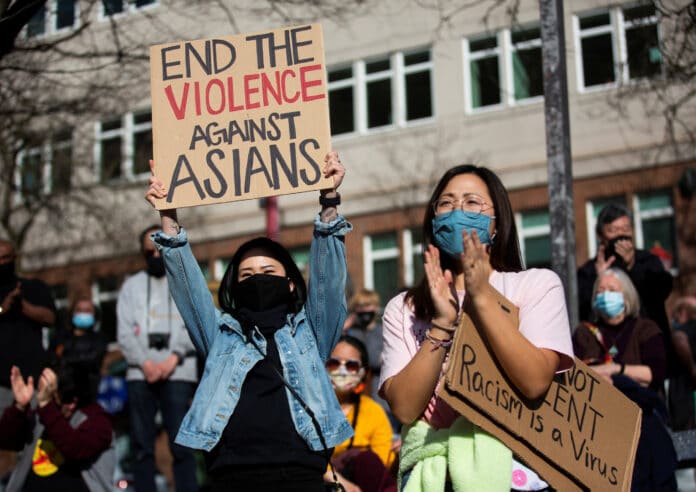Rosa Nanasi Haas, Socialist Alternative (ISA in US)
On March 16, eight people were killed in a deadly shooting in Atlanta with six of the victims being Asian women. In the aftermath, many news outlets refused to call the shooting a hate crime. A police officer who arrived on the scene said that the gunman’s actions were “not racially motivated” but a result of “sexual addiction.” The perpetrator of these crimes, Robert Aaron Long, was clearly motivated by deeply held sexism and racism.
This act came in the context of growing violence against Asian Americans in the U.S. including a sharp rise in hate crimes targeting Asians. The Center for the Study of Hate and Extremism found anti‐Asian hate crimes increased from 49 crimes in 2019 to 122 in 2020, an increase of 149%. Since the event in Atlanta, there have been more instances of anti-Asian violence including an Asian-American woman being attacked in downtown San Francisco by two men later in March.
In response to these most recent attacks along with protests around the country against anti-Asian violence, Biden signed a bill into law on May 20th which merely seeks to gain a “more complete understanding” of hate crimes through data collection. The narrow legal definition of hate crimes and their underreporting is a huge problem and will remain so even after the bill, as Biden’s technocratic focus on number crunching is completely insufficient in preventing actual hate crimes from occurring and terrorizing Asian communities. Instead, we must start at the root of the current surge in anti-Asian hate crimes.
Rising Sinophobia rooted in inter-imperialist rivalry with China
Sinophobia, always present in the background of U.S. history, is rising to the fore today because of the U.S. conflict with China. The dominant priority of the U.S. ruling class today is to reassert American imperialism on a global scale and undercut growing Chinese state capitalism. This is a key underpinning for many of Biden’s policy decisions thus far. Biden’s latest infrastructure bill, which provides for much-needed though still totally insufficient infrastructure spending, is explicitly aimed at beating China and hands out hundreds of billions in corporate subsidies to “position the United States to out-compete China.”
From Obama’s military “pivot to Asia” to Trump’s “kung flu” to Biden’s plans to outcompete China, the U.S. ruling class is ramping up its inter-imperialist rivalry with China. In order to build public support for escalating the economic war and arms race against China, the political establishment and corporate media are waging an intensive propaganda campaign against China. Trump directly used racist jingoist themes to distract from the disastrous handling of Covid which then fed directly into hatred toward Asian Americans.
Biden’s approach is different in tone but still overtly and intensely nationalist. He has quietly continued Trump’s tariffs on China, and is reviving Trump’s “China lab” conspiracy theory on COVID-19 origins. Of course, the anti-China campaign is always accompanied with symbolic professions against hate crime. The goal of the campaign is to prepare the population for further escalation of conflict against China. Similarly, before and during the war for oil and prestige in Iraq, the political establishment (including leading Democrats) and the corporate media intensified Islamophobia to terrible heights and turned a blind eye to horrific anti-Muslim discrimination and violence.
Instead of Trump’s crude, blatant racism, Biden has wrapped his foreign policy priorities up in a “democracy offensive.” This serves two purposes. One, it is a means to prop up “democratic” American imperialism whose credibility has taken a big hit on a global scale, especially with the drastic mishandling of the pandemic and then Trump’s failed January 6 coup attempt. Second, it attempts to build public support internationally by front loading the question of fighting against the brutal, totalitarian Chinese regime. In reality, the U.S. ruling class is only concerned about “democracy” that serves the interest of U.S. imperialism. They are not genuinely concerned with the interests of ordinary people in China and Hong Kong facing brutal repression. That’s precisely why we need genuine working class solidarity between U.S. and Chinese workers against repression.
Capitalism’s history of discrimination and hate crimes against Asians
The latest wave of Sinophobia seen around the country is not new but part of a long history of violence against and scapegoating of Asians. The ruling class has pushed specifically anti-East Asian propaganda both to divide the working class and as a part of economic and military conflicts arising from U.S. imperial ambitions in East Asia. The first law that was passed in this country that specifically blocked immigrants because of their race and class was the Chinese Exclusion Act of 1882, which banned Chinese laborers from coming to the U.S. for ten years and made them ineligible for naturalization. Showing what the current administration’s economic rhetoric against China could lead to, this law was justified by claiming that Chinese workers were coming to the U.S. to steal people’s jobs in the middle of the post-Gold Rush bust.
During WWII, Democratic President Franklin Roosevelt ordered the imprisonment of every Japanese American (roughly 120,000) in “internment camps” and sold their homes and belongings. Japanese Americans deemed a potentially treacherous “fifth column” were a casualty of a war driven by U.S. imperial rivalry with Japan for control of the Far East.
Although working-class immigration from mainly China had led to stereotypes of Asians as “coolies,” that stereotype has in recent decades shifted to the “model minority.” This stereotype comes from the cruel system of U.S. immigration which blocks or hinders working-class immigration while inviting wealthy elites. The U.S. has not updated its limits on the number of immigrants since the 1990 Immigration Act, and a single country is limited to 7% of total immigration. This means immigration from China is limited to largely reflect the desires of U.S. employers, who prefer to fill the immigration “quota” with engineers and other highly skilled professionals. That China can supply these professionals is in turn attributable to the legacy of its planned economy, which laid the basis for Chinese state capitalism, in developing a well-educated workforce and sustaining economic growth. Nonetheless, even these professionals face such huge backlogs that in 2018, employment-based green cards were estimated to take an average of 56 years to process. Yet an immigrant capitalist with over $1 million dollars invested in the U.S. is allowed to skip the line. This is creating a new stereotype of extremely wealthy Asians, reinforced with vaudeville-like TV shows that flaunt their fortunes. Working-class Asian people and their history is erased and the spotlight is shone on middle class and wealthy Asians. This also creates fodder for right-wing populists who can misdirect popular anger against the rich toward specific minorities.
Role of the working class in fighting hate crimes
In the 1980s, the ruling class sought to check the rise of Japan’s economy, for example blaming Japan for the decline of America’s mismanaged auto industry. This led to anti-Asian attacks including the infamous death of Vincent Chin, beaten to death by a Detroit auto plant manager and his stepson for supposedly causing layoffs at their Chrysler plant.
In response to Chin’s murder, United Auto Workers threatened to strike if his attacker continued employment at Chrysler. The manager was soon fired. This is an example of what unions can do to demand justice for and fight against hate crimes. However the UAW leadership was not without fault, as they had weeks earlier stoked economic anxiety and racial animosity by smashing Japanese-made cars for show. Unions must refuse to take part in Sinophobia and oppose both protectionism and neoliberal free trade deals. The U.S. ruling class hopes to overwork and underpay American labor to “outcompete” China, while shuffling off-shored jobs from China to Thailand, Vietnam, or other countries that the U.S. elite can more easily control. It’s very understandable that workers want to stop the loss of American jobs, but protectionism’s true nature is to serve the ruling class and will hurt both the American and Chinese working class. Only a united working class, in solidarity across national borders, can end the race to the bottom and fight against the bosses’ imperative to “outcompete” each other by squeezing more out of labor. Unions must defend their Asian members and fight against anti-Asian hate crimes and discrimination in the workplace.
Attacks against Asians have not just been carried out by white perpetrators, but Black perpetrators as well. In recent weeks, there have been a slew of articles that have come out blaming Black people for the horrific hate crimes perpetrated against Asians. These articles put forward the idea that some media outlets have hidden the race of the perpetrators of violence because they are Black. This right-wing narrative is part of a longer history of pitting Black and Asian people against each other on the basis of race, while overlooking the class antagonisms that underlie tensions between Black and Asian communities. In the 1960s when the U.S. moved away from quota-based immigration to “skill-based” immigration, a wave of college-educated, middle-class Korean immigrants came to the U.S. but could not find work in professions they had trained for because of discrimination and the language barrier. Instead they became small business owners, mostly in poor Black communities where property was cheaper and poverty hampered the growth of Black small businesses. This sparked bitterness on both sides, culminating in attacks on Korean-owned businesses during the LA riots in the 1990s after the acquittal of the white police officers who savagely beat Rodney King. These attacks are not senseless, but a direct result of the capitalist system that funneled middle-class Asian immigrants into ruthless competition with Black businesses, savagely exploited the Black working class into poverty, and promoted racist stereotypes to cover for the system’s inability to provide decent living standards for workers of all races.
Today, the gentrification of Black neighborhoods is driven by profit-seeking property developers, speculators, and gentrifiers who are largely white, but in some cases include wealthy Chinese investors. The state’s demonization of Chinese people and demonstrated apathy toward anti-Asian hate crime make Asians an easy target for attacks. But much like how Vincent Chin was not responsible in any way for Chrysler’s layoffs, the victims of anti-Asian attacks are not gentrifiers or wealthy investors who live in security. Hate crimes are always reactionary and can never be justified. Anti-Asian attacks terrorize Asian workers and elderly while the corporate media places the blame on the Black poor and working class. The working class must not fall for this divide-and-conquer approach, but instead unite to fight against gentrification and for building affordable, high-quality public housing.
Building working-class solidarity is our only real protection against racist violence. The technocratic approach of Asian celebrities and Democratic politicians is severely limited because the U.S. ruling class cannot be “lobbied” on this issue as it needs to build social support for its escalating conflict against China. Additionally the insufficient anti-hate media campaign from NGOs is centered around appeals to American identity, on displays of patriotism to dissuade attacks from fellow Americans, which excludes Asian immigrants (a large portion of Asians in the U.S.) and pushes U.S. nationalism that is ultimately responsible for Sinophobia in the first place. The police are not effective at stopping the rise in hate crimes either. They let Aaron Long carry out one of the worst mass shootings at massage parlors thirty miles apart, and continue to justify his actions. The police let white supremacist vigilantes get away with committing crimes against Asians and people of color regularly. In response to this rise in hate crimes, we don’t need more bloated police budgets as some are calling for, but community control of the police so they can be directed to respond to actual crimes instead of tear-gassing activists.
We cannot end hate crimes as long as the interests of profit leads to the demonizing of whole populations as part of economic warfare. The U.S. and China will do whatever they need to in order to defend their national interests despite the toll on working people who face the brunt of this conflict. The escalating inter-imperialist rivalry between the two countries, a natural outcome of global capitalism, will increase anti-Asian hate crimes. The only way to end racist and sexist violence against Asians and bring the change that is desperately needed is to build a multi-racial, multi-gendered, working-class movement connected to an international struggle against inequality, racism, sexism, sinophobia and any form of oppression experienced around the world. This will require leadership from unions who need to join the struggle to end violence against Asians and Black people and have zero tolerance for racism in any form. As the capitalist system is exposing its internal contradictions and weaknesses now more than ever, it has never been more clear that we need to build a socialist world created and run democratically by workers not the billionaires. This means replacing the capitalist system of international trade, based on extracting profit and violent competition for market share, with international trade on the basis of social need between a federation of socialist states.
Socialist Alternative demands:
- Broaden the definition of hate crimes! Working and oppressed people need to determine what constitutes a hate crime not the police or both parties of big business!
- Unions must refuse to take part in the current economic war against China. Only a united working class, in solidarity across national borders, can end the race to the bottom and fight against the bosses’ imperative to “outcompete” each other by squeezing more out of labor. Unions must defend their Asian members and fight against anti-Asian hate crimes and discrimination in the workplace.
- Build a multi-racial, multi-gender mass movement to challenge all forms of racism, including racial violence against Asian Americans, and extreme sexism. Unions internationally need to take up the struggle against hate crimes and oppression of all working-people.
- Both major political parties have demonstrated their loyalty to the racist, sexist and oppressive system of capitalism. We should have no trust that either major party can represent us. We need to build a new fighting multiracial working class political party, independent of big business, out of our struggles.
- The whole system is guilty – Malcolm X said: “You can’t have capitalism without racism.” To win lasting change, the fight against Anti-Asian violence, police racism, and the corporate political establishment must be expanded internationally into a fight against the capitalist system itself and for a socialist alternative.




